It looks like you're using an Ad Blocker.
Please white-list or disable AboveTopSecret.com in your ad-blocking tool.
Thank you.
Some features of ATS will be disabled while you continue to use an ad-blocker.
share:
There is no doubt that the Radiation from Japan will travel around the Globe but this is NOTHING in comparison to when Both the U.S., Soviets and
eventually China were setting of Multi-Megaton Thermonuclear Blasts in the Atmosphere for years!
And let's not forget CHERNOBYL! This area will be Radioactive for Thousands of Years!
The reality is that we do things every day that Poison Us! Every time a person spills a bit of Gas on their hand while filling up their Car...it absorbs through the skin and is Highly Toxic. Every time a person drinks coffee or tea from a cheap Ceramic Cup loaded with Cadmium...again...Poison! Never mind Booze, Drugs, Water that comes from Old Pipes, Super Type Glue on your fingers that contains Cyanide, Mold Spores that a person Breaths in from a Moldy Attic that has a leak...the list is endless.
Point is...even though this Radiation is not a Good thing...there are Plenty of other Bad things out there that people don't seem to pay attention to...such as RADON GAS coming in from your homes cellar. Split Infinity
And let's not forget CHERNOBYL! This area will be Radioactive for Thousands of Years!
The reality is that we do things every day that Poison Us! Every time a person spills a bit of Gas on their hand while filling up their Car...it absorbs through the skin and is Highly Toxic. Every time a person drinks coffee or tea from a cheap Ceramic Cup loaded with Cadmium...again...Poison! Never mind Booze, Drugs, Water that comes from Old Pipes, Super Type Glue on your fingers that contains Cyanide, Mold Spores that a person Breaths in from a Moldy Attic that has a leak...the list is endless.
Point is...even though this Radiation is not a Good thing...there are Plenty of other Bad things out there that people don't seem to pay attention to...such as RADON GAS coming in from your homes cellar. Split Infinity
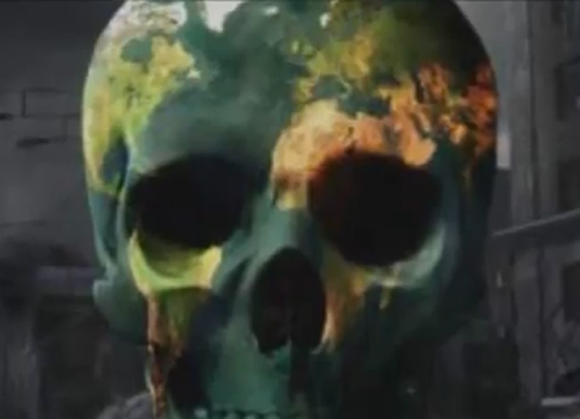
[align=center][font=times new roman][color=fuchsia]“I have become Death,
the destroyer
of worlds”[/font][/align]
Robert Oppenheimer, quoting the Bhagavad Gita,
on witnessing the first atomic bomb test, 1945
March 16, 2011 Statement by Dr. Helen Caldicott
My heart goes out to the people of Japan who are of course suffering under the double blow of the effects of the earthquake and tsunami, as well as the threat from the Fukushima reactors. They are dealing stoically and with great dignity with conditions that are severely challenging.
The world is now paying – and will pay however severe Fukushima turns out to be – a grave price for the nuclear industry’s hubris and the arrogance and greed that fueled their drive to build more and more reactors.
What’s more, having bamboozled gullible politicians, the media, and much of the public into believing that it is a “clean and green” solution to the problem of global warming, the nuclear industry has operated facilities improperly, with little or no regard for safety regulations, and they have often done this with the connivance of government authorities.
Nuclear power is not the answer to global warming; it is not clean, it is not green; it is not safe; and it is not renewable.
[align=center][font=times new roman][color=fuchsia]It is instead “a destroyer of worlds.”[/font][/align]
It is time the global community repudiated it – however economically painful in the short term that taking such a step would be.
There is no other choice for the sake of future generations.
Dear Reader, as you well know, we have been sounding the alarm for over a year now.
But people refuse to acknowledge the tell-tale signs that something is seriously wrong.
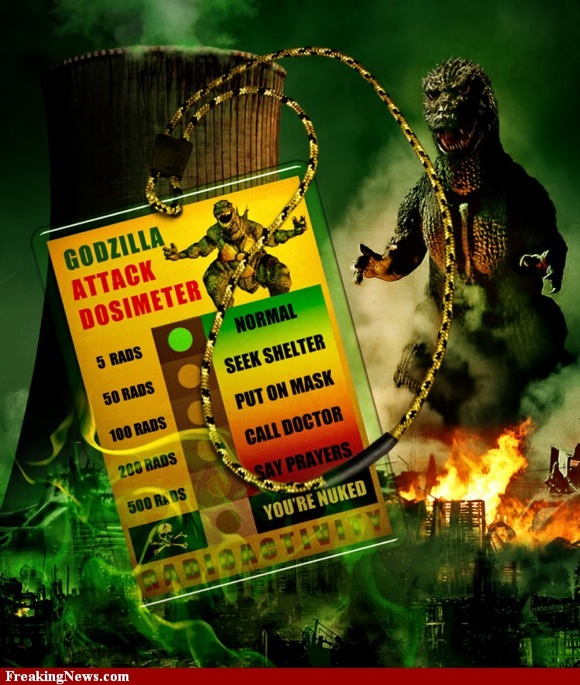
This interesting story from April, 2011.
EPA to raise limits for radiation exposure while Canada turns off fallout detectors
(NaturalNews) The mass radioactive contamination of our planet is now under way thanks to the astonishing actions taking place at the Fukushima nuclear facility in Japan.
As of last night, TEPCO announced it is releasing 10,000 tons of radioactive water directly into the Pacific Ocean.
That 2.4 million gallons of planetary poison being dumped directly into the ocean.
Quick, fudge the numbers
before anybody notices!
Fukushima, you see, is doing to the Pacific Ocean what BP and the Deepwater Horizon did to the Gulf of Mexico last summer.
Except that in the case of Fukushima, that radiation doesn't just disappear with the help of millions of gallons of toxic chemicals.
Nope, that radiation sticks around for decades.
So what to do? If you're the United States Environment Protection Agency (EPA, for those in Rio Linda), there's only one option:
[color=chartreuse]Declare radiation
to be safe!
Yes indeed, friends, we have reached a moment of comedic insanity at the EPA, where those in charge of protecting the environment are hastily rewriting the definition of "radioactive contamination" in order to make sure that whatever fallout reaches the United States falls under the new limits of "safe" radiation.
The EPA maintains a set of so-called "Protective Action Guides" (PAGs).
These PAGs are being quickly revised to radically increase the allowable levels of iodine-131 (a radioactive isotope) to anywhere from 3,000 to 100,000 times the currently allowable levels.
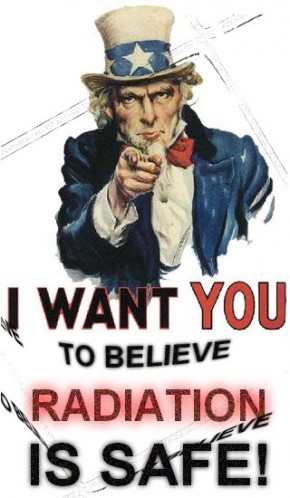
It's just too bad
that the lives of all
citizens on Planet Earth
are at stake.
And all the while the fingers are pointed at Japan, take a look a what's in the Heartland.
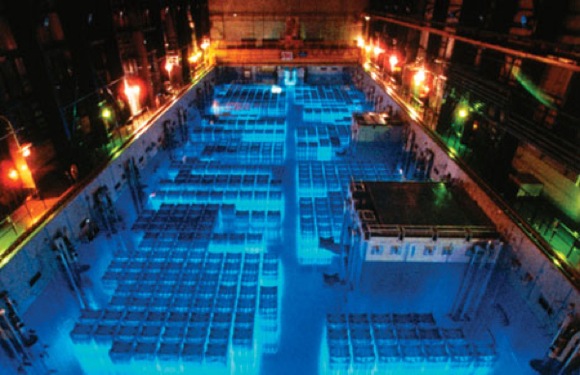
US stores spent nuclear fuel rods at 4 times pool capacity | COTO Report
In a recent interview with The Real News Network, Robert Alvarez, a nuclear policy specialist since 1975, reports that spent nuclear fuel in the United States comprises the largest concentration of radioactivity on the planet: 71,000 metric tons.
Worse, since the Yucca Mountain waste repository has been scrapped due to its proximity to active faults (see last image), the US Nuclear Regulatory Commission has allowed reactor operators to store four times more waste in the spent fuel pools than they’re designed to handle.
[color=chartreuse]Each Fukushima spent fuel pool holds about 100 metric tons, he says, while
each US pool holds from 500-700 metric tons.
A single pool fire would release catastrophic amounts of radioactivity, rendering 17-22,000 square miles of area uninhabitable.
That’s about the size of New Hampshire and Vermont – from one pool fire.
In a March 25th interview, physician and nuclear activist Dr Helen Caldicott explains that “there’s far more radiation in each of the cooling pools than there is in each reactor itself…. Now the very short-lived isotopes have decayed away to nothing.
But the long-lived ones, the very dangerous ones, Cesium, Strontium, Uranium, Plutonium, Americium, Curium, Neptunium, I mean really dangerous ones, the long-lived ones – that’s what the fuel pools hold.”
Nuclear waste, in the form of tiny pellets, are loaded into metal rods, that are then bundled into a “fuel assembly.” The assemblies are stored inside casements that are then submerged in cooling pools that are located at the top of a nuclear reactor, as the following images reveal:
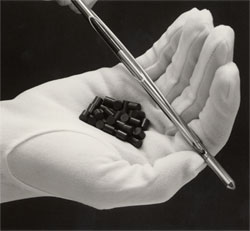

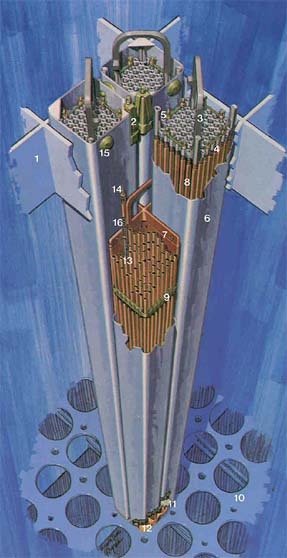
The image at the top of the article shows an entire pool filled with these assemblies. There are millions of these rods around the planet, reports Reuters.
At the end of 2009 there were 218,853 spent fuel rod assemblies in storage in the United States,
according to the Congressional Research Service. The number grows every year.
Assemblies like those used at the Fukushima plant typically contain between 80 to 100 fuel rods, which means that there are now millions of rods being stored around plants.
Of the total, only 49,121 assemblies were in dry casks or otherwise stored remotely, leaving the vast majority to lie in cooling pools like at the Fukushima facility.
Rods can stand about 20 feet high and even a decade after use can emit enough radiation to kill a person standing nearby.
...But the casks, which hold about 10 tons of waste each, sell for about $1 million -- a cost that can be difficult to swallow for utilities...Reuters
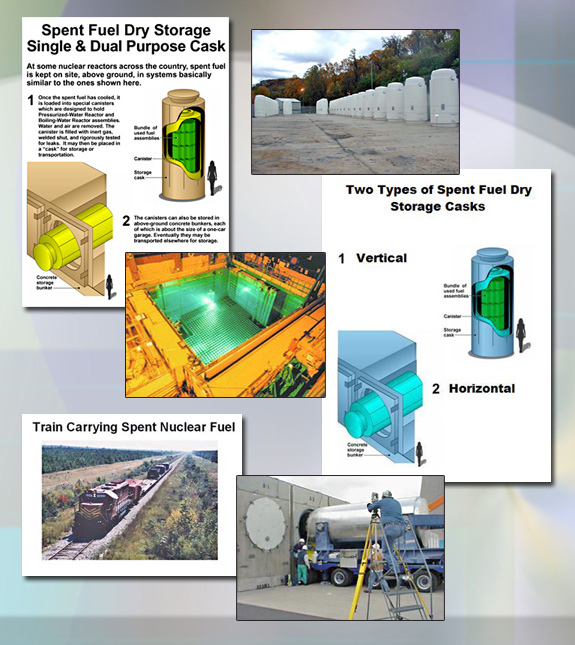
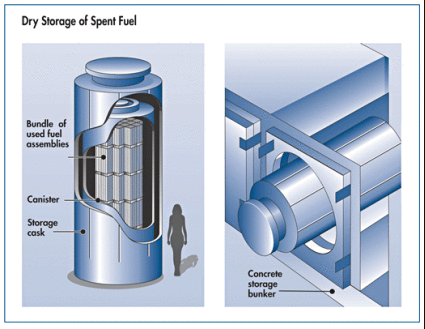
As a Senior Scholar at the Institute for Policy Studies, Alvarez was part of a multidisciplinary international team that looked at possible terror attacks on nuclear facilities, focusing on the spent fuel storage pools.
In 2003, they released a report, Reducing the Hazards from Stored Spent Power-Reactor Fuel in the United States, which calls for transferring the spent fuel from the pools into dry-cask storage. (Summary here).
The report recommends that 75% of the spent rods be removed from each of the pools and stored in ultra-thick concrete bunkers capable of withstanding aerial impact.
The project would take about ten years and would “reduce the average inventory of 137Cs (radioactive cesium) in U.S. spent-fuel pools by about a factor of four.”
The NRC attempted to suppress the IPC report, Alvarez says.
“The response by the Nuclear Regulatory Commission and nuclear industry was hostile.” But the National Academy of Sciences agreed that a fire in an overloaded fuel pool would be catastrophic. The NRC attempted to block the Academy’s report, as well.
The NRC serves industry, not the public, and by controlling the purse strings, Congress has forced the NRC to “greatly curtail its regulatory programs,” says Alvarez.
Engineer Keith Harmon Snow couldn’t agree more. He recently lambasted the NRC and mainstream media for downplaying the ongoing catastrophe in Japan. He notes that,
“The atomic bomb that exploded at Hiroshima created about 2000 curies of radioactivity. The spent fuel pools at Vermont Yankee Nuclear Plant (U.S.) are said to hold about 75 million curies.”
And that’s just one US nuclear plant, out of 104, not to ignore the undisclosed number of research sites. Then consider that several nuclear plants sit on geologic faults, as this image by Public Integrity reveals:
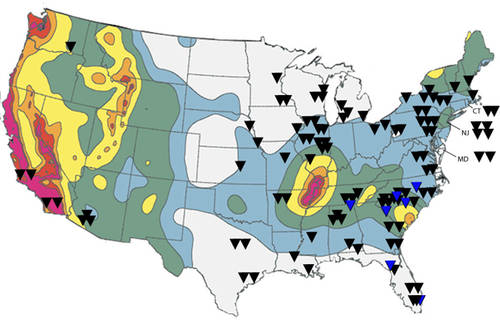
Also see this global map of earthquake activity and nuclear power plant locations.
Nuclear waste is a serious, deadly and growing problem that the industry refuses to address, preferring to externalize disposal costs onto the public (even suing the US government to clean up its mess for them, under a 1998 law it no doubt favored).
Unless the radioactive waste is laser-launched toward the sun, we’re stuck with waste that will contaminate the biosphere for thousands of years, for the measly prize of 25-30 years of electricity, as nuclear activist and mathematician Gordon Edwards so eloquently explained.
The risk far outweighs the benefit;
this energy choice
exemplifies the insanity
of the nuclear industry
and its government protectors.
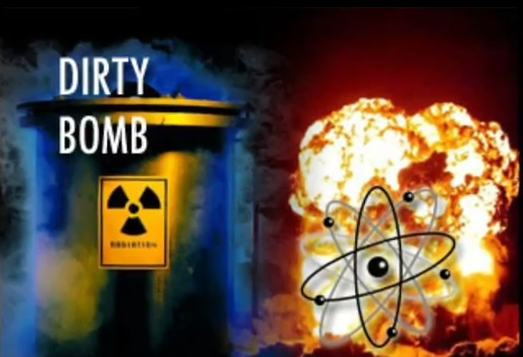
US Spent Nuclear Fuel Largest Concentration Of Radioactivity On Planet
BOB ALVAREZ: Well, we have the largest inventory of spent fuel in the world. It's about--it's been recently reported to be at this time about 71,000 metric tons. And it really represents the largest concentration of radioactivity on the planet...
Well, I mean, it's not a pretty picture in this country right now, because of the Congress dominated by politicians who want to take a meat ax to programs that protect our public safety, feed our children, reduce the hardship of the poor, and all these things.
I mean, for example, the House passed funding legislation recently that cut off all funding for the federal program to issue tsunami warnings.
It's a very difficult environment right now. So--but I think that the public should do everything they can, if they have these nuclear power plants anywhere near their backyards, is to call their members of Congress to task about fixing this problem.
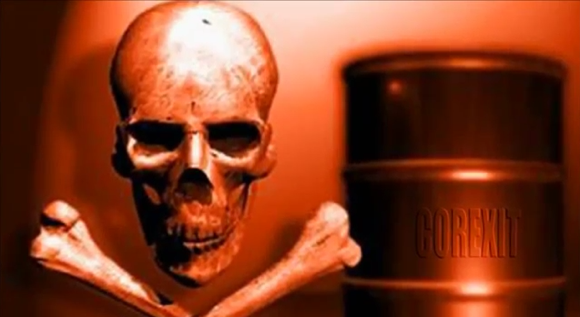
[color=chartreuse]“A nuclear reactor is not really producing electricity so much as it is producing two things:
long-lived nuclear waste which lasts for millions of years and plutonium which lasts for many thousands of years.
The electricity is just a little drop in the bucket.
It’s a little flash in the pan.
You get electricity
for maybe 20 or 30 years
if you’re lucky,
then you have plutonium forever.”
Peace Love Light
tfw
[color=magenta]Liberty & Equality or Revolution
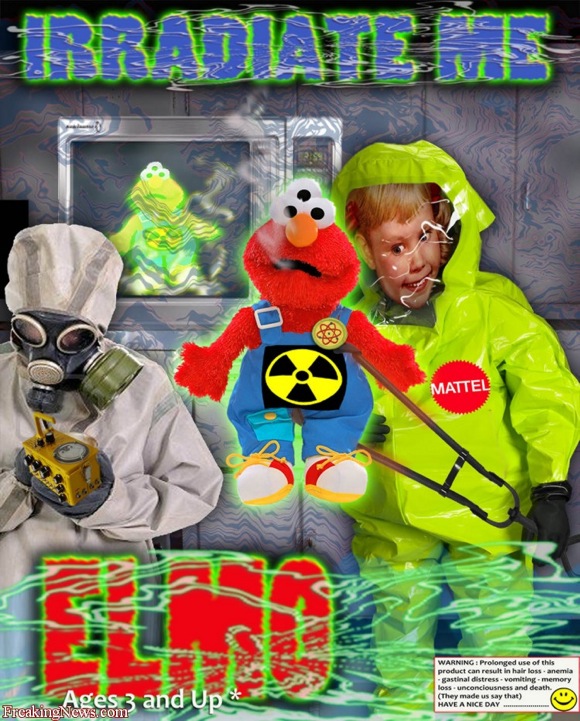
“In a time of universal deceit
telling the truth is considered a revolutionary act."
George Orwell
FAIR USE NOTICE
Fair Use has been an important part of Copyright Law for 170 years. The Supreme Court has erred on the side of Fair Use and Free Speech whenever challenged on this issue.
It is also known and accepted that new creative works are often based on or referenced to existing material.
This post to this website may contain copyrighted material - the use of which has not always been specifically authorized by the copyright owner and every attempt is made to give credit where due.
We are making such material available in effort to compliment, illustrate, criticize, discuss and preserve a variety of environmental, humanitarian, political, cultural, economic, democratic, criminal justice, scientific, social justice, human/animal/hybrid, health and radiation rights issues.
All the works contained herein are meant to illuminating and transformative and do not negatively impact the original copyright holders' financial benefit in any substantive way.
This constitutes a 'fair use' of any such copyrighted material as provided for in Title 17 section 107 of the US Copyright Law and therefore requires NO prior authorization for its use.
edit on 2/9/2012 by thorfourwinds because: color
S I, I realize there is a lot of fallout from previous nuke test and accidents up in the atmosphere, but those don't explain why my readings have
steadily increased since I started testing last November.
Last night [Sept 7th] I tested my rain here in eastern Ontario. It was fine. 0.20 micro-sieverts per hour. 80 miles east of me, in Ottawa the numbers were a lot higher.
Just before lunch today [Sept 8th] I went out and tested my downspout. Well, I broke all my past records again.
34 X background
One correction. It had been raing here at least 5 hours if not all night, before I tested.
Last night [Sept 7th] I tested my rain here in eastern Ontario. It was fine. 0.20 micro-sieverts per hour. 80 miles east of me, in Ottawa the numbers were a lot higher.
Just before lunch today [Sept 8th] I went out and tested my downspout. Well, I broke all my past records again.
34 X background
One correction. It had been raing here at least 5 hours if not all night, before I tested.
Since you seem to be thorough, what about all the other plants in that area of Japan? Fukushima Daicihi was NOT the only compromised plant, yet it is
the ONLY one we hear about. All of the other plants in that area were compromised and I believe all are closed and I've not heard anything about them
since I first posted on a forum about them. In all there are about 11 affected reactors in all of the affected sites, but no one EVER mentions all the
others...
Coal power worse than nuclear?
www.ornl.gov...
Partly because of these concerns about radioactivity and the cost of containing it, the American public and electric utilities have preferred coal combustion as a power source. Today 52% of the capacity for generating electricity in the United States is fueled by coal, compared with 14.8% for nuclear energy. Although there are economic justifications for this preference, it is surprising for two reasons. First, coal combustion produces carbon dioxide and other greenhouse gases that are suspected to cause climatic warming, and it is a source of sulfur oxides and nitrogen oxides, which are harmful to human health and may be largely responsible for acid rain. Second, although not as well known, releases from coal combustion contain naturally occurring radioactive materials--mainly, uranium and thorium.
www.ornl.gov...
reply to post by Opportunia
We all know and have our suspicions about what is going on at other sites like Daini or Onagawa, but with our media and government watchdogs in bed with Tepco/government of Japan..... we get nothing in the way of credible info.
Some info on DAINI from July 012 that I've never seen but it doesn't seem to say which reactor? Hmmmmm.
"At the Fukushima Daini nuclear power plant, it may be safer inside the reactor buildings than it is outside them."
"JRT, which went on a media tour of Daini on Wednesday, found that background radiation levels in the plant compound were around 0.5 to 1.0 microsieverts per hour — some 16 to 33 times higher than prior to the March 2011 accident."
"On the second level, around the containment vessel, radiation levels still hovered around 0.6 microsieverts per hour. But they shot up inside the containment vessel to 6 microsieverts per hour near the pipes and valves where steam from the reactor goes through, and to 160 microsieverts per hour at the bottom part of the vessel, called the pedestal, which is right under the reactor."
[Does that mean there is a crack in the bottom of the preasure vessel? It can't be normal?]
And they end with " less than the amount of a chest X-ray." of course!
blogs.wsj.com...
See what I mean?.... Two years of articles hinting at lots but saying nothing.
We all know and have our suspicions about what is going on at other sites like Daini or Onagawa, but with our media and government watchdogs in bed with Tepco/government of Japan..... we get nothing in the way of credible info.
Some info on DAINI from July 012 that I've never seen but it doesn't seem to say which reactor? Hmmmmm.
"At the Fukushima Daini nuclear power plant, it may be safer inside the reactor buildings than it is outside them."
"JRT, which went on a media tour of Daini on Wednesday, found that background radiation levels in the plant compound were around 0.5 to 1.0 microsieverts per hour — some 16 to 33 times higher than prior to the March 2011 accident."
"On the second level, around the containment vessel, radiation levels still hovered around 0.6 microsieverts per hour. But they shot up inside the containment vessel to 6 microsieverts per hour near the pipes and valves where steam from the reactor goes through, and to 160 microsieverts per hour at the bottom part of the vessel, called the pedestal, which is right under the reactor."
[Does that mean there is a crack in the bottom of the preasure vessel? It can't be normal?]
And they end with " less than the amount of a chest X-ray." of course!
blogs.wsj.com...
See what I mean?.... Two years of articles hinting at lots but saying nothing.
Some crackpot on the radio last night was talking about how Cobalt-60 has been stockpiled by the North Koreans, and how 1 'dirty' bomb with a
Cobalt-60 casing material exploded over Alaska would kill everyone in Alaska, Canada, and half the USA. So I just had to look up how dangerous
Cobalt-60 was. Hmm...
Effects of Cobalt-60 Exposure on Health of Taiwan Residents Suggest New Approach Needed in Radiation Protection
www.ncbi.nlm.nih.gov...
Effects of Cobalt-60 Exposure on Health of Taiwan Residents Suggest New Approach Needed in Radiation Protection
The conventional approach for radiation protection is based on the ICRP's linear, no threshold (LNT) model of radiation carcinogenesis, which implies that ionizing radiation is always harmful, no matter how small the dose. But a different approach can be derived from the observed health effects of the serendipitous contamination of 1700 apartments in Taiwan with cobalt-60 (T1/2 = 5.3 y). This experience indicates that chronic exposure of the whole body to low-dose-rate radiation, even accumulated to a high annual dose, may be beneficial to human health.
www.ncbi.nlm.nih.gov...
www.RadiationNetworks.com
Inside Fukushima's Nuclear Reactor Evacuation Zone with Geiger Counters
www.youtube.com...
Inside Fukushima's Nuclear Reactor Evacuation Zone with Geiger Counters
www.youtube.com...
How to build a geiger counter / radiation detector from household materials.
www.youtube.com...
You could potentially save hundreds of USD.
www.youtube.com...
You could potentially save hundreds of USD.
Originally posted by g146541
Did something happen that none of us know of?
Oh the Japanese thingie, are all of the Japanese dead yet?
Hmmm after they die, i'll .....no i still won't worry.
I have the worlds 2nd largest kelp farm in between me and Japan.
are you still so ..confident?
JAPAN has LITERALLY LOST Their MINDS! Fukushima update 7/25/14
Published on Jul 25, 2014
[…] Your Head will explode after they finish telling you where the want to put the nuclear waste they have produced. Forking MONJU Fast Breeder Reactor w/ OVER 9.000 MISSED SAFETY CHECKS and a TERRIBLE "SAFETY RECORD", or 'in a hole in the ground" on and EARTHQUAKE PLAGUED COUNTRY?!
[…]
"Agency: Nuclear waste can be DIRECTLY disposed of"
The Japan Atomic Energy Agency is reported to be looking at the direct disposal of spent nuclear fuel instead of reprocessing it.
[…] If spent nuclear fuel is buried 1,000 meters underground for 1 million years, the radiation level at the earth's surface will peak in 3,000 years, at 0.3 microsieverts per year.
[…] Japan's nuclear power plants have accumulated 17,000 tons of spent nuclear fuel.
[…] Professor Tatsujiro Suzuki at Nagasaki University says the conclusion that direct disposal is possible is a very important step forward. Suzuki is a former member of the government's Atomic Energy Commission.
a reply to: thorfourwinds
I live in Hawaii which at the last look of a map much closer to Japan than our beloved West Left Coast on the mainland so therefore find it very hard to believe that the coast lowered by 15 feet due to the earthquake in Japan. No changes what so ever here, all sealife is thriving and near as I can tell we haven't slipped below the ocean...yet.
I was in Tokyo last year and life is going on as usual so again I always find it hard to believe that someone with a "pocket" dosimeter named Hal that find and preach otherwise.
That said the consequences of Fukushima are not readily apparent and will change life in Japan but an ocean of water will help prevent the doom and gloom that Hal claims in his rants and rambles.
I live in Hawaii which at the last look of a map much closer to Japan than our beloved West Left Coast on the mainland so therefore find it very hard to believe that the coast lowered by 15 feet due to the earthquake in Japan. No changes what so ever here, all sealife is thriving and near as I can tell we haven't slipped below the ocean...yet.
I was in Tokyo last year and life is going on as usual so again I always find it hard to believe that someone with a "pocket" dosimeter named Hal that find and preach otherwise.
That said the consequences of Fukushima are not readily apparent and will change life in Japan but an ocean of water will help prevent the doom and gloom that Hal claims in his rants and rambles.
a reply to: DJMSN
Greetings:
Thank you for your 'real' info from the Western front.
Interesting, our buddy Clif High said that there was a 14-ft. drop in elevation where he lives in the Pacific northwest...If memory serves correctly, Computerman took us to task over a mere mention of that… lol.
Independent scientists are calling Fukushima the BIGGEST health crisis mankind has ever faced.
If memory serves correctly, our friend Dr. Helen Caldicott (our first Twit follower..lol) has been warning us saying the same thing … seems like forever…Hmmm…1,386 days of 24/7/365 FALLOUT is FOREVER.
Speaking of our beloved West Coast (we grew up in Laurel Canyon); this from our friend Susan Duclos…
heartbreaking personal stories relating brain tumors to Fukushima ionizing radiation.
The End of California? Fukushima Radiation And Related Deaths - YouTube
Greetings:
Thank you for your 'real' info from the Western front.
Interesting, our buddy Clif High said that there was a 14-ft. drop in elevation where he lives in the Pacific northwest...If memory serves correctly, Computerman took us to task over a mere mention of that… lol.
Independent scientists are calling Fukushima the BIGGEST health crisis mankind has ever faced.
If memory serves correctly, our friend Dr. Helen Caldicott (our first Twit follower..lol) has been warning us saying the same thing … seems like forever…Hmmm…1,386 days of 24/7/365 FALLOUT is FOREVER.
Speaking of our beloved West Coast (we grew up in Laurel Canyon); this from our friend Susan Duclos…
heartbreaking personal stories relating brain tumors to Fukushima ionizing radiation.
The End of California? Fukushima Radiation And Related Deaths - YouTube
Published on Nov 5, 2014
The truth is being hidden from the American people.
It is an ugly truth and the mainstream media and US government isn't even attempting to inform the public, but people are dying, found all around California obituaries, from brain tumors and brain aneurysms, which one of the main causes listed is radiation.
Put one in the win column!
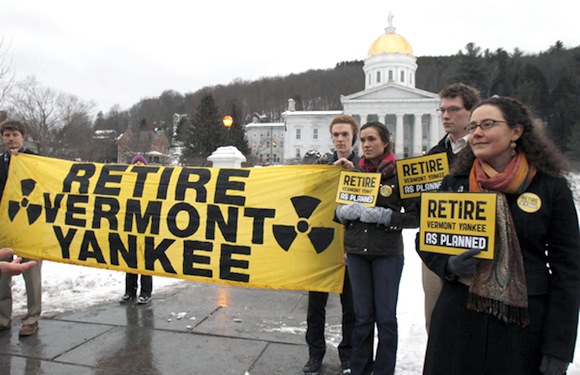
Activists Permanently Shut Down Vermont Yankee Nuke Plant Today
29 December 2014
The Vermont Yankee atomic reactor goes permanently off-line today, Dec. 29, 2014. Citizen activists have made it happen. The number of licensed U.S. commercial reactors is now under 100 where once it was to be 1,000.
Decades of hard grassroots campaigning by dedicated, non-violent nuclear opponents, working for a Solartopian green-powered economy, forced this reactor’s corporate owner to bring it down.
Read the rest at: EcoWatch.com ecowatch.com...

Activists Permanently Shut Down Vermont Yankee Nuke Plant Today
29 December 2014
The Vermont Yankee atomic reactor goes permanently off-line today, Dec. 29, 2014. Citizen activists have made it happen. The number of licensed U.S. commercial reactors is now under 100 where once it was to be 1,000.
Decades of hard grassroots campaigning by dedicated, non-violent nuclear opponents, working for a Solartopian green-powered economy, forced this reactor’s corporate owner to bring it down.
Read the rest at: EcoWatch.com ecowatch.com...
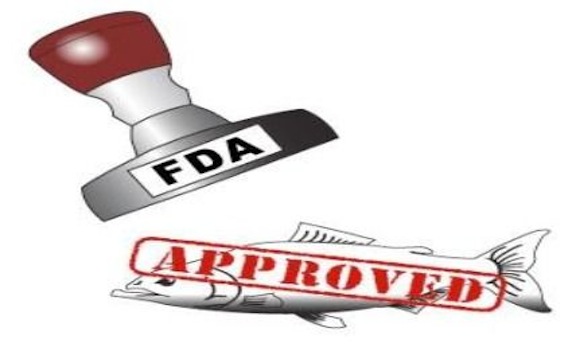
24 February 2015
The FDA.
The ones that kept claiming there is no radiation problem, just put out this HUGE list of foods now banned from import.
They now seize it on sight.
If you have any of these food products DON'T be eating them.
Import Alert # 99-33
Published Date: 02/24/2015
Type: DWPE Import Alert Name: Detention Without Physical Examination of Products from Japan Due to Radionuclide Contamination.
***February 2015, the Government of Japan ordered the addition of the Iwate, Miyagi and Gunma Prefectures and the removal of the Ibaraki Prefecture for milk, filled milk, and milk-based infant formula.
Also the addition of eel from the Chiba Prefecture; the correction of milk to raw milk, Braddblotched rockfish to Brass Blotched Rockfish, the removal of Cultivatied wasabi, starspotted smooth-hound, Flathead Flounder, Gurnard, Halfbeak, Littlemounth Flounder, and Northern Sea Urchin, and the addition of Turnips and Scorpion Fish from the Fukushima Prefecture; the removal of Tea leaves, Nibe Croaker, Olive Flounder and Pacific Cod from the Ibaraki Prefecture; the removal of buckwheat from the Iwate Prefecture; the removal of buckwheat, Olive Flounder, and Panther Puff and the addition of Wild Araila Sprouts from the Miyagi Prefecture; and the addition of Koshiabura from the Nagano Prefecture.***
FDA recognizes that the government of Japan is taking steps to address this issue and FDA will continue to provide support to their efforts.
Guidance:
Districts may detain, without physical examination, the specified products from firms in the Fukushima, Aomori, Chiba, Gumna, Ibaraki, Iwate, Miyagi, Nagano, Niigata, Saitama Shizuoka, Tochigig, Yamagata and Yamanashi prefectures.
FDA and the Japanese government will continue to collaborate to ensure products from the affected prefectures do not pose a health risk to U.S. consumers. FDA will continue monitoring the public health risks due to radionuclide contamination, and when appropriate will remove the Import Alert and resume routine coverage of entries.
Questions or issues involving import operations should be addressed to the Division of Import Operations at 301-796-0356.
For questions or issues concerning science, science policy, sample collection, analysis, preparation, or analytical methodology, contact the Office of Regulatory Science at 301-796-6600.
Product Description:
PRODUCTS:
All specified products from the affected noted prefectures in Japan (see "Charge" section for listing).
02A[][]05 Rice, Cultivated, Whole Grain
09[][][][] Milk/Butter/Dried Milk Products
14[][][][] Filled Milk/Imitation Milk Products
16A [][][] Fish, N.E.C.
16E[][]02 Venus Clams
16M[][]11 Sea Urchin/ Uni
17[][][][] Meat, Meat Products, and Poultry
(beef, boar, bear, deer, duck, hare and pheasant products only)
20[][][][] Fruit/Fruit Prod
21[][][][] Fruit/Fruit Prod
22[][][][] Fruit/Fruit Prod
24[][][][] Vegetables/Vegetable Prod
25[][][][] Vegetables/Vegetable Prod
40C [][]99 Formula Products (Milk) Baby
40C [][]01 Milk based formula
PROBLEM: Radionuclide Contamination
Charge:
For milk, filled milk, *** and milk-based infant formula, *** from the affected prefectures of Fukushima, ***Iwate, Miyagi and Gunma*** and Tochigi in Japan:
"The article is subject to refusal of admission pursuant to Section 801(a)(3) in that it appears to contain a radionuclide, a poisonous or deleterious substance which may render it injurious to health. [Adulteration, Section 402(a)(1)]"
OASIS Charge Code: RADIONUC
AND, for the listed products from the indicated prefectures:
AOMORI PREFECTURE:
Wild Mushrooms
CHIBA PREFECTURE:
Sh1take mushrooms;
Bamboo shoots;
Common Carp;
Sliver Crucian Carp
Eel
Boar
FUKUSHIMA PREFECTURE:
Raw Milk;
Wild Aralia Sprout;
Azuki Bean;
Bamboo Shoot;
Non-head type leafy vegetables (i.e. turnip), flower head brassicas (i.e. broccoli and cauliflower);
Head type leafy vegetables (i.e. Spinach, Lettuce, Celery, Cress, Endive, Escarole, Chard, and Collards);
Chestnuts;
Wild Japanese Butterbur Scrape;
Japanese Royal Fern;
Kiwi Fruit;
Koshiabura (wild tree sprout);
Log-grown #ake mushrooms;
Log-grown Pholiota Nameko (outdoor cultivation)
Mushroom;
Ostrich Fern;
Pteridium Aquilinum (bracken fern);
Rice;
Soybean;
Turnips;
Ume;
Giant Butterbur;
Uwabamisou;
Yuzu Fruit;
Alaska Pollock;
Ayu(excluding farm raised);
Barfin Flounder;
Black cow-tongue;
Black rockfish;
Brass blotched rockfish;
Brown hakeling;
Salmon (landlocked) (excluding farm raised);
Common Carp(excluding farm raised);
Conger Eel;
Fat Greenling;
Flathead;
Fox Jacopever;
Goldeye rockfish;
Black Porgy;
Dace;
Eel;
Sandlance (excluding juvenile);
Sea bass;
Long Shanny;
Marbled Flounder;
Nibe Croaker;
Ocellate Spot Skate;
Olive Flounder;
Pacific Cod;
Panther Puffer;
Poacher;
Red Tongue Sole;
Ridged-eye Flounder;
Rockfish (Sebastes cheni);
Scorpion Fish
Sea Raven;
Shotted Halibut;
Slime Flounder;
Spotted Halibut;
Starry Flounder;
Stone Flounder;
Surfperch;
Venus Clam;
Vermiculated Puffer;
Whitespotted Char(excluding farm raised);
Bear meat;
Beef;
Boar;
Cooper Pheasant;
Green Pheasant;
Hare Meat;
Spot-Billed Duck
GUMNA PREFECTURE:
Wild Mushrooms;
Salmon (landlocked) (excluding farm raised);
Whitespotted Char (excluding farm raised);
Bear meat;
Boar;
Copper Pheasant;
Venison;
IBARAKI PREFECTURE:
Log-grown Sh1take mushrooms;
Bamboo shoots;
Koshiabura (wild tree sprout);
Sea bass;
Eel;
Rockfish;
Ocellate Spot Skate;
Channel Catfish(excluding farm raised);
Stone Flounder;
Sliver Crucian Carp (excluding farm raised);
Boar
IWATE PREFECTURE:
Bamboo shoots;
Log-grown Brick-cap mushrooms (outdoor cultivation)
Log-grown #ake mushrooms;
Log-grown Pholiota Nameko (outdoor cultivation)
Wild Mushrooms;
Wild Japanese parsley;
Royal fern;
Koshiabura (wild tree sprout);
Pteridium aquilinum (bracken fern);
Soybean;
Dace;
Black Porgy;
Sea bass;
White spotted Char(excluding farm raised);
Bear meat;
Beef;
Venison;
Cooper Pheasant
MIYAGI PREFECTURE:
Royal Fern;
Bamboo Shoots;
Koshiabura (wild tree sprout);
Wild Araila Sprout
Ostrich Ferns;
Rice;
Log-grown Sh1take mushrooms (outdoor cultivation);
Wild Mushrooms;
Soybean;
Ayu (excluding farm raised);
Salmon (landlocked) (excluding farm raised);
Black Porgy;
Dace;
Sea bass;
White spotted Char (excluding farm raised);
Beef;
Bear Meat;
Boar meat
NAGANO PREFECTURE:
Wild Mushrooms
Koshisabura
NIIGATA PREFECTURE:
Bear Meat
SAITAMA PREFECTURE:
Wild Mushrooms
SHIZUOKA PREFECTURE:
Wild Mushrooms
TOCHIGI PREFECTURE:
Wild Aralai Sprouts;
Bamboo Shoots;
Chestnuts;
Wild Japanese Peppers;
Wild Royal Fern;
Koshiabura (wild tree sprout);
Wild Pteridium aquilinum (bracken fern);
Wild Ostrich Ferns;
Log-grown Brick-cap mushrooms (outdoor cultivation)
Log-grown Sh1take mushrooms;
Log-grown Pholiota Nameko (outdoor cultivation)
Wild Mushrooms;
White spotted Char (excluding farm raised);
Beef;
Boar meat;
Venison
YAMAGATA PREFECTURE:
Bear Meat
YAMANASHI PREFECTURE:
Wild Mushrooms
a reply to: thorfourwinds
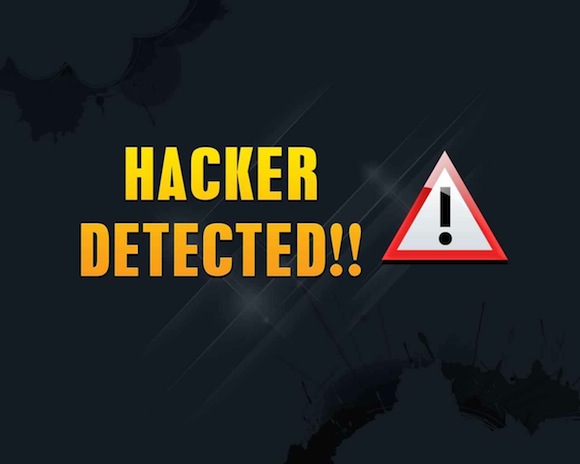
RE: My immediate previous post.
Soooo, why does the 'recent' link take one to this previous post/poster?
FDA Radionuclide Contamination
Banned List of Japanese Food
www.abovetopsecret.com...
And why does a 'direct link' take one to this previous post/poster?
www.abovetopsecret.com...
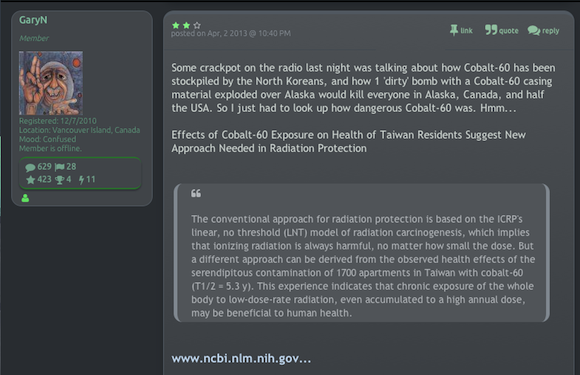
So much for posting this on social media…thanks ATS.
ArMaP: where are you when we need you?

RE: My immediate previous post.
Soooo, why does the 'recent' link take one to this previous post/poster?
FDA Radionuclide Contamination
Banned List of Japanese Food
www.abovetopsecret.com...
And why does a 'direct link' take one to this previous post/poster?
www.abovetopsecret.com...

So much for posting this on social media…thanks ATS.
ArMaP: where are you when we need you?
edit on 3/3/2015 by thorfourwinds because: ttyyppooss
edit on 3/3/2015 by
thorfourwinds because: ttyyppooss
St. Louis American: Legislators call attention to North County radioactive dump - YouTube
Uploaded on Feb 18, 2010
A river floodplain is probably the worst place to store radioactive waste, said Robert Criss, a geology professor at Washington University.
But in fact, thats where such waste has ended up after Mallinckrodt Chemical Works started producing uranium for atomic bombs in 1942 right next to the Missouri River floodplain.
The waste landed only eight miles upstream from Missouri American Water Company's intake for drinking water in Florissant that supplies all of North County. Thats also upstream from the Chain of Rocks water intake, a main supplier for St. Louis city's water.
Dumped illegally in 1973, the waste is now buried in the West Lake landfill, west of Interstate 270 on St. Charles Rock Road. As the radioactive waste gets older, it becomes more dangerous, said representatives of Missouri Coalition for the Environment.
ST. LOUIS PREPS FOR "CATASTROPHIC" NUCLEAR EVENT
Published on Oct 9, 2015
Beneath the surface of a St. Louis-area landfill lurk two things that should never meet: a slow-burning fire and a cache of Cold War-era nuclear waste, separated by no more than 1,200 feet.
Part 1
Emergency St Louis Nuke Dump Fire 6700+ Tons a Chernobyl?
Published on Oct 14, 2015
AP: Catastrophic event could release radioactive fallout over major U.S. metropolitan area
— Gov’t issues emergency plan as fire burns near nuclear site
— Report: “World is on brink of nuclear disaster”
— Senator: “What we have… could end up as Chernobyl”
Beneath the surface of a St. Louis-area landfill lurk two things that should never meet: a slow-burning fire and a cache of Cold War-era nuclear waste, separated by just 300 meters…
Authorities have quietly adopted an emergency plan in case the smoldering embers ever reach the waste, a potentially ‘catastrophic event‘ that could release radioactive fallout in a plume of smoke over a densely populated area of suburban St. Louis…
[T]he plan for a worst-case scenario was developed only a year ago and never publicized until this week…
If the underground fire reaches the waste, “there is a potential for radioactive fallout to be released in the smoke plume and spread throughout the region,” according to the disaster plan.
The plan calls for evacuations… in St. Louis County… and perhaps the federal government, would be called upon to help…
Missouri Attorney General, Sep 3, 2015: BREAKING NEWS – Attorney General Chris Koster released today new reports from expert witnesses [that] paint a troubling picture of the environment surrounding the landfill site…
Drs. Joel Burken and Shoaib Usman… at Missouri Univ. of Science and Technology, detected radiological… contamination in trees on the property of neighboring landowners… these findings “indicate the off-site migration of RIM [radiologically impacted material], either in groundwater or aerial transport of particulate matter”…
Drs. Tony Sperling [and] Ali Abedini [concluded] the fire has moved beyond both lines of gas interceptor wells… in the direction of the OU-1 radiological area…
Todd Thalhamer, a civil engineer… with extensive experience investigating landfill fires, concluded that what he described as a “catastrophic event” at the landfill “was foreseeable and preventable.”…
Dr. Timothy Stark, PhD and professional engineer… observed significant slope degradation and areas where the waste mass had settled, suggesting the underground waste had been consumed by a smoldering / combustion event… “These reports underscore what has been clear from the beginning."
—Republic Services does not have this site under control,” Koster said… “it appears that it has poisoned its neighbors’ groundwater and vegetation.”…
Part 2
St Louis Nuke Dump Could Cause a Fukushima on Mississippi
Published on Oct 14, 2015
Part 3
St Louis Sub Surface Nuke Fire City Prepares Evacuation Plans
Published on Oct 14, 2015
If the “sub-surface smoldering event” reaches the radiological area, there is a potential for radioactive fallout to be released in the smoke plume and spread throughout the region…
This event will most likely occur with little or no warning. Officials… are aware of the possible occurrence of an emergency or major disaster requiring an emergency shelter in place or evacuation…
It may be necessary to request assistance through… federal sources.
Missouri Senator Maria Chappelle-Nadal, Sep 17, 2015 (at 27:00 in): “There are references that are in the reports that the Attorney General did with independent scientists where they say that what we have under the ground could end up as Chernobyl. What I am concerned about are the 40,000 tons of uranium that have been spread all over the place…
We’re talking about the most potent uranium in the world… We’re looking at the cancer clusters… We’re looking at the number of children who have double sets of teeth, children who have missing eyeballs, the number of children who have brain tumors.
"This is not consistent with a normal community whatsoever.”
St. Louis Post-Dispatch Editorial, Oct 10, 2015: Mr. Koster released reports last month saying an underground fire at the Bridgeton Landfill was moving toward radioactive waste in the adjacent West Lake Landfill…
[S]ome of the radioactive contamination was found outside of West Lake… [A]n order from the Missouri Department of Natural Resources [was made] to prevent the chemical reaction from spreading to the north (West Lake) and possibly igniting…
Something must be done and it should not take a cataclysmic event to make that happen.
St. Louis Public Radio, Sep 17, 2015: Missouri Attorney General Chris Koster released reports that radiation from the West Lake Landfill… has spread to neighboring properties. The reports also suggested that an underground fire… is moving toward radioactive waste and could reach it as soon three to six months.
Daily Star, Oct 8, 2015: Nuclear disaster fears as fire nears Cold War bomb dump; The world is on the brink of a nuclear disaster as fire rages towards a cache of Cold War nukes
— A secret emergency plan has been drawn up as an underground blaze creeps towards a waste dump containing radioactive waste from the Manhattan Project.
The leaked document warns a “catastrophic event” will be triggered if the nuclear material is ignited… radioactive smoke could erupt over the densely-populated area of St Louis.
Source Jeff Rense with Yoichi Shimatsu Fukushima update interview with Rense and can be found at rense.com... 10/12/2015
a reply to: thorfourwinds
"independent scientist" == hysterical blogger non-scientist?
The biggest health crisis mankind has ever faced? Worse than, uh, the Black Death? Smallpox for millenia?
A plague in 165-180AD killed one third of the Roman Empire.
the consequence of closing nuclear is burning more coal --- which has actual documented specific health effects?
Independent scientists are calling Fukushima the BIGGEST health crisis mankind has ever faced.
"independent scientist" == hysterical blogger non-scientist?
The biggest health crisis mankind has ever faced? Worse than, uh, the Black Death? Smallpox for millenia?
A plague in 165-180AD killed one third of the Roman Empire.
the consequence of closing nuclear is burning more coal --- which has actual documented specific health effects?
originally posted by: mbkennel
a reply to: thorfourwinds
Independent scientists are calling Fukushima the BIGGEST health crisis mankind has ever faced.
"independent scientist" == hysterical blogger non-scientist?
The biggest health crisis mankind has ever faced? Worse than, uh, the Black Death? Smallpox for millenia?
A plague in 165-180AD killed one third of the Roman Empire.
the consequence of closing nuclear is burning more coal --- which has actual documented specific health effects?
please , if you would , define scientist.
and , as a matter of nomenclature, how radiological environmental elements are analogous to biological environmental elements, as a matter of pure science, or even basic observation ..? just curious , thanks.
new topics
-
Does the Trump win mean No More Taylor Swift??
Politicians & People: 3 hours ago -
Trump-appointed judge blocks Biden administration overtime rule
Social Issues and Civil Unrest: 5 hours ago -
Don't cry do Cryo instead
General Chit Chat: 10 hours ago
top topics
-
Don't cry do Cryo instead
General Chit Chat: 10 hours ago, 11 flags -
Gen Flynn's Sister and her cohort blow the whistle on DHS/CBP involvement in child trafficking.
Whistle Blowers and Leaked Documents: 16 hours ago, 8 flags -
Does the Trump win mean No More Taylor Swift??
Politicians & People: 3 hours ago, 8 flags -
Trump-appointed judge blocks Biden administration overtime rule
Social Issues and Civil Unrest: 5 hours ago, 6 flags -
Tariffs all around, Except for ...
Dreams & Predictions: 12 hours ago, 5 flags
active topics
-
Mind Blowing - SpaceX Successfully Catches Super Heavy Booster Rocket
Space Exploration • 57 • : gortex -
Tariffs all around, Except for ...
Dreams & Predictions • 20 • : FullHeathen -
How long till it starts
US Political Madness • 18 • : EyeoftheHurricane -
WATCH LIVE: US Congress hearing on UFOs, unidentified anomalous phenomena
Aliens and UFOs • 89 • : putnam6 -
Russia Ukraine Update Thread - part 3
World War Three • 6812 • : Oldcarpy2 -
Post A Funny (T&C Friendly) Pic Part IV: The LOL awakens!
General Chit Chat • 7778 • : baddmove -
Does the Trump win mean No More Taylor Swift??
Politicians & People • 18 • : Oldcarpy2 -
Mike Tyson returns 11-15-24
World Sports • 59 • : Flyingclaydisk -
Trump sues media outlets -- 10 Billion Dollar lawsuit
US Political Madness • 48 • : Oldcarpy2 -
Trump-appointed judge blocks Biden administration overtime rule
Social Issues and Civil Unrest • 4 • : nugget1
